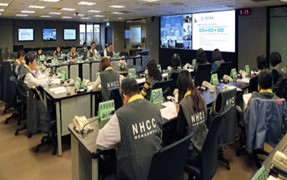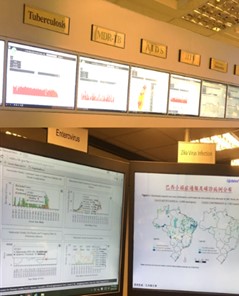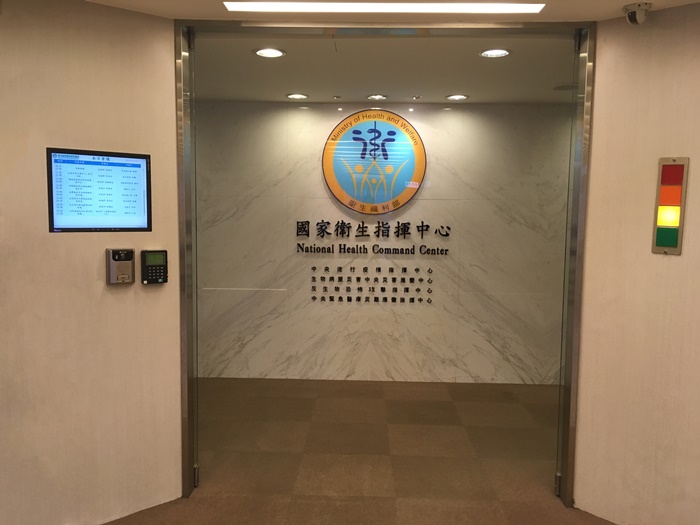NHCC
In 2003, the global epidemic SARS relentlessly tested Taiwan’s capability for public health emergency management. There was an urgent need for a disaster -management center that focused on -large outbreak response and act as the operational command point for direct communications among the central, regional and local authorities. In response, with the CDC as the base, the government established the National Health Command Center (NHCC) in 2004. There was also a global trend to establish such a command center in response to public health emergencies. In addition, in 2015, the WHO released guidance on how to develop a command center. During the same period, the WHO’s Joint External Evaluation tool also pointed out the importance of establishing an EOC. The WHO also specifically listed emergency response operation as one of the 19 key elements.
The National Health Command Center (NHCC) addresses public health emergency and provides disaster information for decision-makers. It is a unified central command system that includes the Central Epidemic Command Center, the Biological Pathogen Disaster Command Center, the Counter-Bioterrorism Command Center and the Central Medical Emergency Operations Center. This joint framework serves as a comprehensive platform for preventing major epidemics.
The organizational design of the NHCC enables effective coordination and operations, which includes coordination center, situation room, commander office, administrative office, conference room, media watch room, operation room, data center, utility room, records room, lounge and remaining office space.
The layout is very important for a command center because emergency events are unpredictable. The NHCC can accommodate approximately 100 persons at the same time, which allows prompt response and high efficiency.
Attached Files
The NHCC relies on cutting-edge technology and advanced communications network to achieve maximum capacity of the public health emergency management system. With these resources, the NHCC can keep up with the international community, enhance professionalism and mobilization.
● Video conferencing
The NHCC installed the GSN Internet-based video conference system which consists of large TV screens and an online booking mechanism. This video conference system can facilitate the communication between regional centers, local governments, hospitals and health authorities worldwide. The NHCC can also coordinate with regional commanders, command centers and experts through this video conference system. Stakeholders can also access meetings with mobile devices.
● Media Watch Room: News feed reception and surveillance
The media watch room collects infectious disease-related news, information, and announcements from television, newspaper, the internet and other sources. During an emergency, it receives the latest data from SNG signal.
● Communication System
The communication system integrates the NHCC phone networks and maintains accessible hotlines among command centers for receiving or delivering the message. With the teleconference system that connects different centers, commanders and experts can communicate without the limitations of space and time. The NHCC is also equipped with radio and satellite phones as alternatives in case the teleconference system fails.
● Environmental control and AV equipment
Multiple high-tech visual media sources display comprehensive information to commander and decision-makers and provide a dynamic operating environment for information exploration.
● Emergency Operation Center
To reinforce the public health emergency response efficiency and to be in line with International Health Regulations (IHR) and the Global Health Security Agenda (GHSA), the NHCC established Emergency Operation Center (EOC) in 2016.
The NHCC holds meetings and video conferences with regional offices, local health authorities, and departments worldwide regularly. It is also responsible for media surveillance, facility maintenance, NHCC guidance, personnel training, and exercises. It also provides the latest information about emergency response operation and infectious disease-related guidelines and practices. The NHCC also serves as a contact window for emergency situations.
During an emergency, the NHCC is a platform for local, regional and central government agencies to communicate and make decisions related to actions and resources distribution. This is how the NHCC responds to the public health events as a team and makes accurate choices in time.
Attached Files
Facility Design-Video conferencing.jpg
Facility Design-Media Watch Room News feed reception and surveillance-2.jpg
acility Design-Communication System -3.jpg
Facility Design-Environmental control and AV equipment -4.jpg
Collecting and integrating real-time information is key to winning the war against epidemics. Hence, NHCC set up an information-exchange platform.

The NHCC demonstrates information of indicator-based and event-based epidemic surveillance systems. These systems collect data from multiple databases such as the National Health Insurance (NHI), stockpile systems, Taiwan National Infectious Disease Statistics System and media surveillance. This platform allows the NHCC to analyze global epidemic issues at the earliest time possible and exchange information with other countries through the IHR Focal Point.

The information is available at any time and location with mobile devices. Visual presentation methods provide real-time epidemics warnings for decision-makers' reference. The NHCC integrates information and gives commands in response to the public health emergency.

The NHCC established real-time surveillance systems, well-equipped communication facilities and comprehensive information platforms to achieve the 3 "I"s: Initiation, Integration, and Innovation. The 3 "I"s enable the NHCC to respond to different kinds of crisis such as communicable disease outbreaks, biological disasters, bioterrorism attacks and medical emergencies.
Under central command system, we can coordinate with officials at all levels and can also provide comprehensive information on public health emergency for decision-makers to take timely actions. Therefore, we can respond to the crisis more effectively and safeguard the health of our citizens.
For more information, please contact:
Toll-free hotline:
1922 or 0800-00192

